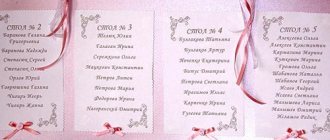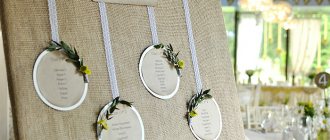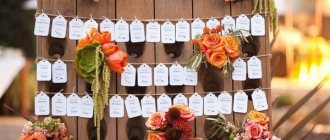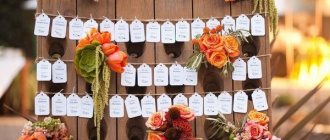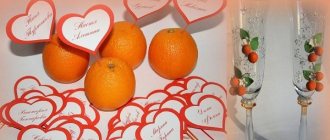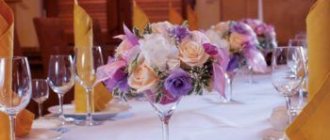Guests, Preparation, Articles, Traditions and entertainment February 3 The Bride
Seating is not just a diagram of tables and names, it is a guarantee of an excellent mood and comfort for everyone present: both you and your guests, and the host. In this article we have collected recommendations for you on wedding seating.
We plan seating in advance
Preparing a seating chart is not something that can easily be completed on the eve of the wedding; it is a serious matter, which, by solving it, you can save yourself from numerous problems during the wedding evening. You can plan your seating in three stages:
- After the guest list has been compiled and the venue has been selected, feel free to sit down and draw up the very first, “raw” seating plan. It’s worth figuring out how many people will sit at one table, how many tables there will be, how you can divide the guests so that they are interested in each other. The layout of the furniture, the number of tables, and therefore the menu and decor, depend on the first seating plan.
- After guests have received invitations and answered “yes/no” by the specified date, a more accurate seating chart can be drawn up. Remove from the plan those who cannot come and distribute the remaining guests according to their age, hobbies, etc. This is usually done at least 2 weeks before the celebration. It is this seating chart that should be sent to the organizer and decorator to prepare the chart and seating cards.
- It happens that one of the guests, due to unforeseen circumstances, cannot come, but someone invites their significant other with them, and you find out about it just a couple of days before the wedding. At the time of such clarifications, a few days before the celebration, the final seating plan should be drawn up. All clarifications must be communicated to your team, and the final list must be sent to the host and banquet manager of the site.
The sooner you start making a plan, the easier it will be to make adjustments later and keep the numerous cost items associated with seating under control.
American scheme
There are so many newlyweds, so many different views on the wedding. Some strive to organize a pompous, pretentious celebration, others - a cheerful family holiday. If you want to focus on simple human communication and active healthy recreation, it is reasonable to focus on the American model of seating and arranging restaurant furniture. We are talking about celebrating a wedding in the form of a buffet table. In America, many have already given up boring gatherings. At the buffet table, you will not only have a pleasant conversation, but also get the benefits of eating food, and not problems with the gastrointestinal tract due to overeating.
Analyzing the guest list
To create a seating plan, you need to analyze the guest list. Make a table in which the first column is the name of the guest; second column - kinship/relationship/family affiliation: for example, friend of the groom or sister of the bride; in the third, indicate the age category. After that, start distributing guests to tables. In this case, you should pay attention to:
- • Age: it is better to seat older guests next to each other so that young people do not disturb them to have a quiet time and relax.
- • With/without a couple: a wedding is a great opportunity to meet interesting people, so it is better to seat single friends and relatives at the same table, but it is better to seat couples together, so they will be more comfortable.
- • Relationships: if a wedding brings together a group of friends who have been together all their lives, regardless of whether they are alone or in pairs, it is better to seat them at the same table: they will be happy to spend the evening together. And if former lovers are invited to the wedding, and even with their current significant other, it is worth seating them at different tables.
- • Hobbies and characters: you know your guests and you will certainly understand who will be more interesting with whom at the table: who is quiet, and who will be happy to have fun. Take this into account when creating your seating plan.
But belonging to the family of the bride or groom should be taken into account only when it comes to relatives who will be very happy to communicate with each other. It is better to seat friends together, regardless of which side they are from: in the future they will have to communicate in your common company.
Determining the type of seating
Depending on the list of guests and the features of the venue, you should decide on the type of seating:
- — European seating: round tables of 8-10 people. This is the most popular seating arrangement and most wedding venues offer this type of seating. If the seating at such tables is too dense, there is a chance that some of the guests will not see the newlyweds during the evening. Therefore, if possible, seat your guests not along the entire perimeter of the table, but only in those places from which you and the groom can be seen.
- — Rectangular individual tables: designed for 6-10 people. An excellent option for those who want to make a more formal dinner and use non-standard table settings. Here you can place the composition along the entire table, seat the guests so that everyone can see the heroes of the occasion. But you should remember that such seating takes up a lot of space in the hall, so plan the space carefully so that there is room for the dance floor and free movement around the hall.
- — Long common table: 1 or 2 common tables without a separate table for the bride and groom. This type is used at small, home, intimate weddings, where the number of guests is small, which means there is no need to set up separate tables and separate guests.
- — The letter “P”: the seating arrangement, familiar to many from the time of our parents, has not lost its relevance, having been slightly adapted to modern standards. The newlyweds' table can be placed a little separately and leave 2 tables for guests. You should avoid dividing guests into two camps: from the groom's side and from the bride's side. This type of seating arrangement is used less and less at weddings: with it, guests from the same company do not have the opportunity to communicate with each other freely, since they can only clearly see the guest sitting next to them and the guests opposite.
How to make place boards and table plans with your own hands
Do you love handicrafts and are you good at it? Create your own guest plan and seating charts. Prepare a list and drawing of the location of tables in the room. Now you can get to work.
Place cards for weddings
The simplest rectangular signs
Even those who have never held colored paper in their hands can make such cards. In addition to simplicity, it is cost-effective and quick to create.
The simplest rectangular signs with your own hands
Materials for the creative process: - colored cardboard;
- paper;
- scissors, pencil, ruler, double-sided tape and glue;
— decorative glitters, sequins, stamps, ribbons and other decorative elements.
Instructions:
— Cut the cardboard into rectangles.
— We fold each rectangle in half. After this, we bend 4-5 cm strips from the narrow sides. We fasten these bends with double-sided tape so that we get a stable triangle.
— We print out the names of the guests on paper and cut the sheets into small rectangles.
— We beautifully decorate the edges of the paper with curly scissors, glue the rectangles with names onto the cardboard using double-sided tape.
— We decorate place cards with sparkles, bows or any other way.
Similar to the name cards, numbers for the tables should be made. Only the size of cardboard for license plates should be taken several times larger.
Placement signs
Placement signs
"Seatings" on skewers and toothpicks
Place cards on skewers stuck into pots of flowers, fruits, sweets, cakes, etc. look quite creative.
"Seatings" on skewers and toothpicks
Materials for the creative process: - colored cardboard;
- scissors, glue, skewers or toothpicks;
— decorative glitters, sequins, stamps, ribbons and other decorative elements.
Instructions:
— We print out many templates for future “seating arrangements” on colored cardboard.
— We print the names of the guests separately on cardboard of a different color.
— We cut out all the details along the contour.
— Glue a toothpick into the center of a larger piece.
— We glue cards with the names of the guests on top.
We display our masterpieces in juicy fruit halves, candies or cupcakes.
Place the table numbers on skewers and place them in narrow vases in the center of the table.
Place cards with pasta decor
Small modest signs made of paper or cardboard can be decorated with farfalle pasta painted with acrylic paints. The cards are secured to the tines of the forks. Very simple, original and beautiful.
Materials for the creative process: - colored cardboard;
- scissors, glue;
— pasta “bows”;
- acrylic paints and brushes;
— decorative glitters, sequins, stamps, ribbons and other decorative elements.
Instructions:
— We print cards with the names of the guests on colored cardboard.
— We decorate the edges with curly scissors.
— We color the dry pasta and glue them onto the cards.
— Insert the place card between the tines of the fork.
Additionally, on a large sheet of paper, draw a plan for the arrangement of tables, sign the names and decorate the space free from lists with colored bows.
Place cards, ideas
Place cards, ideas
Place cards that are attached to the edge of the glass are in fashion. These are all kinds of butterflies, doves, hearts. Small paper figures are simply cut out according to templates and placed on the dishes. Fruits with names carved on them also look very unusual. But this is done by figure cutting masters with a full arsenal of carving knives. When choosing a design for place cards, consider the theme of the wedding and the time of year. In the fall, use small pumpkins, beautiful leaves, and nuts. In summer - butterflies, floral motifs, etc. Follow the suggested recommendations and your wedding will be excellent.
Place cards, ideas
Place cards, ideas
Place cards, ideas
Video - Seating of guests at a wedding, decoration
Seating the most important guests
The most important guests at your wedding are, of course, your parents. And you need to think especially carefully about where to plant them. Firstly, they should be seated at the same table next to each other, because a wedding is a kind of symbol of unity, so they should get to know each other and communicate, and also feel like part of the same family. Whether you give them a separate table or not is up to you, but you should sit them next to you in order to thereby show your respect and gratitude. If you have chosen a non-European seating plan, then you can sit down with your parents: it will be pleasant for both them and you, because your closest ones will be nearby on such an exciting day.
We don’t overload tables
How often do we face the problem “we can’t separate the guests, so instead of the required 10 people, we have 12 at the table”! Of course, it sounds harmless, but it’s better to think 10 times before making such a decision. Each table, regardless of seating plan, is designed for a certain number of people for a reason. For comfortable sitting at the table, there should be at least 60 cm per person, and as the number of people increases, this space is reduced to 40 cm.
This means that guests will sit at the table literally elbow to elbow, and the chairs will be back to back, which will be uncomfortable for both themselves and the waiters. In addition, a large number of guests at the table complicates serving, because there will be much less space for plates, cutlery and food. What to do? Review the seating plan or completely change its type: you can, for example, replace round tables with rectangular ones, and add a smaller table to the rectangular ones.
Important Rules
The first thing you need to know is to leave enough space for guests at the table so that they don’t crowd together or touch each other’s elbows. Ideally, it is believed that there should be a distance of one to one and a half meters between chairs. Less space? What to do, seat the guests more closely, but keep in mind that they will be cramped.
Invitees should be able to see the young people and the places where competitions, dances and other activities take place. Arrange tables so that no one sits near the toilet, kitchen entrance or close to aisles where others will constantly be walking. Also, do not seat anyone with their backs to the young people.
Keep in mind that people need to be told where to go. Typically, one of two options is used for this:
- A seating plan is made with table numbers and names of guests, and cards with their numbers and names are placed on the tables, showing specific seats.
- Guests are assigned to tables only. In this case, the tables themselves have numbers or names, and within the table, guests choose their own seats.
Tali Photography
Making a seating layout
To clearly see what happened after analyzing the guest list, sorting and seating, it is best to make a layout. What will you need for this? If you do not know special computer programs, then prepare a large sheet of paper and cut out tables and chairs in squares and circles, depending on what kind of furniture you will have. This must be done to scale in order to see the real picture, so ask the manager at the site about the size of the room and all the objects that are in it: stage, bar counter, etc. And it’s best to ask him for a diagram of the hall.
Arrange the cut-out tables and chairs according to the seating pattern and to accommodate space for the dance floor or other areas. If in the process of drawing up the layout you see that there is not enough space, it’s time to come up with a plan “B” and change the seating arrangement or move additional areas outside the hall. For example, in the summer you can move the dance floor to the veranda or to the street, if the area allows. Or move the photo zone or wish zone to another room. Be sure to discuss the furniture arrangement with the host and organizer to ensure the plan makes sense.
